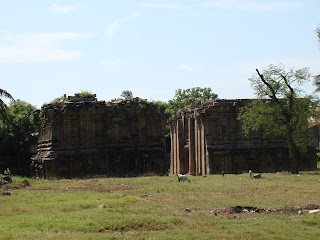Airävateçwara Temple, Däräsuram,
Kumbakonam
The Çiva Temple in Däräsuram is dedicated to Airavateswara.
Built by Raja Raja Chola II (1145-1173 CE), the Temple is in form of a chariot.
This temple was originally
fortified by seven massive walls, and seven prakäras.
However, currently (as I saw in 2010), the beautifully carved, but dilapidated Gopuram
(main entry gate) at a distance from the Temple, stands unrecognizable. It is
completely lost, but the form of which may be imagined from the second Gopuram.
(Just as we try to visualise the main Temple of Konark, seeing the mukhasala
that exists now). The ASI has virtually rebuilt the Temple in recent years. It
is now a UNESCO World Heritage Monument as part of the Great Chola Temples. The pyramidal vimänam (tower) is only 26 metres (85 feet) tall, and
like the temple itself, smaller than the towers of Båhadéswara
and Gaìgaikoëòa Choläpuram.
The Nandi is in a small maëòapa, below the ground level, as
well as the main Temple. The Nandi is also small, compared to the colossal
Nandi in Båhadéswara and Gaìgaikoëòa.
A modest Räjagopuram,
embellished with images of gods and goddesses, in the front as well as the
rear, greets the visitors. The main entrance is propped up by two pillars on
either side. The Temple is a complete Räjagaàbhira-maëòapam housing the sanctum,
ardha-maëòapam, and mahä-maëòapam.
The Räjagaàbhira-maëòapam is built in the form of a
chariot (other Chariot Temples being Konark in Odisha, and Sarangapani in
Kumbakonam), complete with wheels, and galloping horses. There are galloping
horses on either side of the mandapa-extension
with a huge wheel carved behind it.
On both sides at the entrance
steps are small balustrades in the form of elephants (also seen in Sarangapani
Temple), with beautiful makara-sculptured
on their outside.
The makara with a floriated tail, short legs, and curled up snouts, and
a pair of dwarf gana-riders on it
form a lovely decoration.
Inside, delicate, intricate,
miniature stone- carvings depict various Puranic stories. A particularly
spectacular miniature shows Siva on Nandi, flanked by Devas, while the bottom
half depicts dancing girls in various poses.
There is an element of peace and
tranquility in Darasuram, as opposed to the heroic element, which is the keynote
o sculptures at Tanjavur and Gangaikonda Cholapuram. The keynote of the
sculptures in Darasuram Temple is nitya-vinoda - perpetual entertainment.
The pillars of the main maëòapa contain beautiful patterns
of decorative creepers, so arranged that in the circular medallions created
therein, are figures in diverse poses, musicians. These figures are mostly dance
poses, or playing musical instruments, and sometimes some deities.
The profuse occurrence of dance
and musical scenes and figures are indeed striking. One has to recollect that
Chola period was one of the great patronage and encouragement for dance and
music. The Gopurams of Chidambaram subsequently have a number of dance figures
illustrating various sthänas
and karaëas of Bharata’s Näöyaçästra.
|
|
|
The rectangular portions of the pillars are
decorated with small panels illustrating mythological stories (mostly from Çiva Puräëa) , such as attack of Kämadeva
being destroyed by Çiva, Siva’s fight with the asuras, penance of Pärvati, prayer of the
gods for a son of Çiva, the birth of Kumära.
The stories also depict an atmosphere o peace and fulfillment.
The mukha-maëòapa pillars are held by a
strange looking animal with features of at least five animals. – horns of a
ram, trunk of an elephant, mane and legs of a lion, and tail of a cow etc.
You would not believe this. But
the Gaëeça and the next figure above are of one inch in length
each.
An unusual depiction of Çiva
as Çarabha (Çarabheçwara)
destroying Narasiàha is in a niche to which a small maëòapa is provided (reached by a flight of steps).
The outer walls of the maëòapa has some noteworthy Chola
specimens such as, a fine Ardhanäriçwara, unique o its kind with three
faces and eight arms; a four-armed Nägaraja
having snake hoods over his head and hands joined in adoration, Agastya, the
dwarf sage, seated with one of his hands in teaching posture and the other hand
carrying a kamaëòaÿu,
a dancing Märtäëòa-Bhairava or Aghora-Vérabhadra with four hands, three heads
and a terrible countenance.
The outer fortification is
surrounded on the inside by a running verandah, like in most Çiva temples. Over this fortification
are seated Nandis (like in Shore Temple of Mahabalipuram) every ten metres or
so.
There is museum that contains some exquisitely
carved figures. The one on top shows fine workmanship, where a thin straw can
be inserted in the nose of the deity. The pillared hall also can be seen as
well as the family tree o the Cholas.
Strangely there is a Radha-Krshna sculpture on
the outside wall, although Darasuram is a Siva Temple.
As per rules in Iconography, most
temples do depict avatäras
in the temples. Here in Darasuram, the Buddha is depicted on the outside temple
wall in teaching mudrä.
Such interesting combined sculpture
are found in many temples. Speaks a lot about the imagination of the
sculptor/s.
***








































